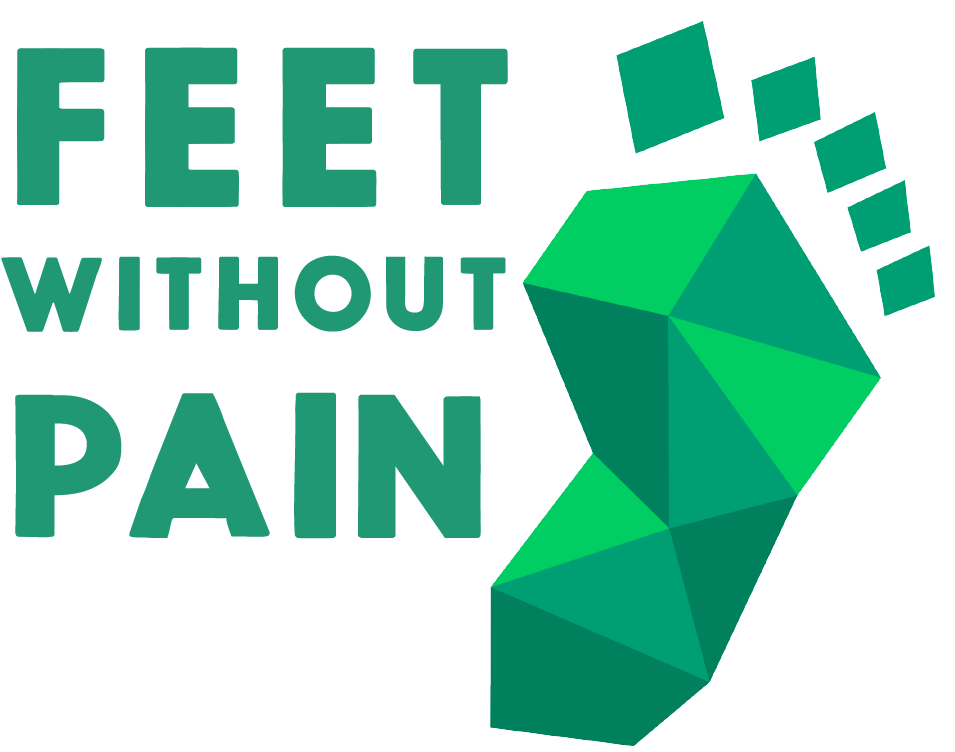Why custom insoles?
Foot, ankle, and knee pain can be caused by various factors, significantly impacting the day-to-day activities of Brazilians. One of the most effective solutions to alleviate these discomforts is the use of Custom Insoles. Here is an overview of the pain landscape in Brazil and the reasons why wearing insoles is beneficial.
Pain prevalence in the Brazilian population
We conducted a survey with 3316 individuals online, exploring the connection between foot characteristics and health-related quality of life.
Have some pain in the knees.
Perform activities without difficulty.
Have or have had foot pain.
- men
- women
The data were collected from the survey titled “Brazilian Feet – An in-depth study of 26,339 people” conducted by Feet Without Pain
What may be the causes of your pain?
Pain in these regions can be attributed to various factors, including both unchangeable factors such as gender, age, and foot type, as well as behavioral factors like standing time, weight, physical activity, and footwear choices. Let’s delve into each of these factors in more detail below.
Foot Type
Foot type refers to the way the sole of the foot makes contact with the ground when we take a step. In a normal foot, approximately half of the arch touches the ground. In the case of pes cavus (high arches), only a small portion of the arch makes contact with the ground (as shown in the figure below). On the other hand, individuals with flat feet have their entire arch touching the ground. Consequently, people with pes cavus or flat feet are more prone to experiencing pain in their feet, ankles, and knees.
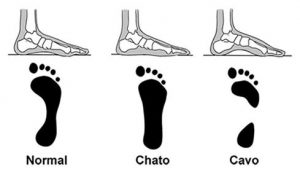
Footwear
Different shoes can cause foot pain, especially with high heels, narrow points, or stiff soles. In addition, regular shoes are made on a large scale and therefore are straight in the inner region to fit any foot type (flat, normal, or cavus). Thus, they lack plantar arch or foot curvature support, impairing weight distribution during walking.
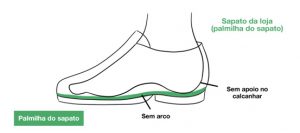
Shoes with heels redistribute the load applied to the feet because they raise the heel, increasing the load on the toes. Below, it is possible to analyze how the weight distribution is modified using high heels.
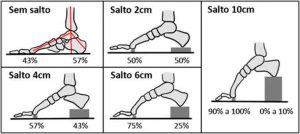
Age
Another critical factor that contributes to pain is age. Older people have more foot pain due to muscle atrophy, joint stiffening, and the body’s natural wear down. They are also more likely to develop other diseases, which can lead to wear and tear and structural misalignment, such as arthrosis.
Sex
The biological difference between female and male bodies directly affects how likely individuals are to develop foot, ankle, and knee pain. Females are more affected than males in all age groups.
The high difference between men and women may be related to the fact that women wear high heels, pointed toes, tighter shoes, and biomechanical and hormonal factors. In addition, women are more predisposed to arthritis, a group of diseases that affects the joints.
Overweight
Weight is directly linked to foot pain. Our feet are responsible for bearing the body’s entire weight. Therefore, the more weight, the greater the pressure on the foot. In addition, constant overload can cause tissue damage or diseases such as heel spurs.
Standing time
Many people report that foot pain increases when they spend much time on their feet. It happens due to the constant overload on the feet, with no tissue recovery time, leaving the region vulnerable to injuries.
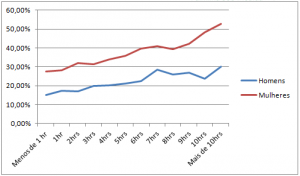
Sedentary Lifestyle
The practice or not of physical activity is another factor related to the presence of pain in the population. People who practice physical activity have less foot pain compared to sedentary people. This fact can be explained by the lack of physical preparation and muscle strength of non-practitioners, leading to less stable joints, which are more prone to injuries.
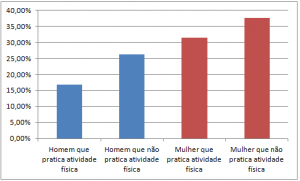
Most common places to feel pain
Pain can appear in different leg or foot regions, regardless of why the person develops them. The following is a diagram representing the most common sites of pain:
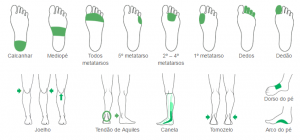
People have, on average, between 2 and 3 pain sites simultaneously. The most affected region is the heel, with an approximate incidence of 40%, followed by the metatarsals (30%) and the arch of the foot (25%).
Diagnosis of Pain
Many of the pains in the lower limbs can represent a specific pathology, usually due to continuous stress on the ligaments, fascia, and foot bones, causing inflammation and pain. The most common pathologies are:
Plantar Fasciitis
It is an inflammation of the plantar fascia, the tissue that extends from the heel to the toes’ base. Symptoms are pain in the sole and heel region. These discomforts get worse with physical exercise. To avoid them, one should stretch the fascia, align the foot and support the plantar arch.
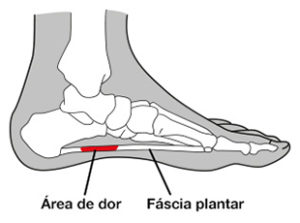
Calcaneal Spur
The calcaneal spur is a bony bulge on the heel due to excess pressure. The heel spur is widespread in obese people and people who firmly hit their heels on the ground since these factors increase the pressure on the site. In these cases, it’s usual to feel stabbing pain in the heel, especially on the first step of the day. The nuisances reach the calcaneus region’s tissues since the spur itself does not cause pain. The pressure on the tissues covering the heel must be removed for these cases. Read more about heel spurs.
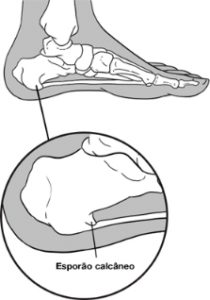
Metatarsalgia
Metatarsalgia is a pain in the metatarsal bones caused by excessive pressure. Usually, this discomfort is described as pain in the foot’s “chubby” region in front of the toes. For these cases, support for the foot arch must improve to remove pressure from the metatarsals. An elevation (pilot) is also placed next to the bones to enhance their position. Read more about metatarsalgia.
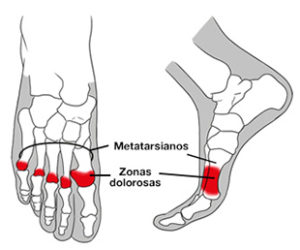
Morton’s Neuroma
Morton’s Neuroma is an evolution of metatarsal pain caused by a thickening of the nerve that passes between the fingers. The symptoms of this disease are numbness, discomfort between the fingers, and shock pain when stepping or compressing the front of the feet.
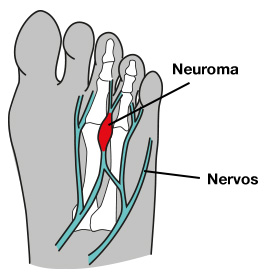
Sesamoiditis
Sesamoiditis is the inflammation of two small bones located below the 1st metatarsal. This injury is caused by excess pressure in the region, usually linked to pronated stepping (when the foot deflects inwards) or the use of high heels. For these cases, pressure must be removed from the first metatarsal, improving support on the plantar arch and placing the pilot (subtle elevation below the metatarsals).
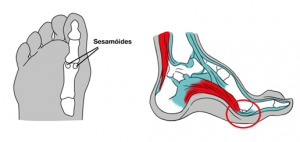
Ankle Pain
Generally, pain in the region is caused by foot misalignments and gait errors. First, you need to identify the way the footstep misalignment occurs. An internal elevation is placed in the insole in pronated steps (when the foot deviates inwards) to correct the deviation. In supinated steps (deviation of the foot outwards), a lateral elevation is used to obtain the ideal alignment of the ankle. Read more about ankle pain.
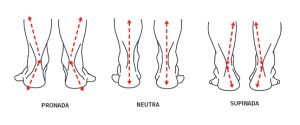
Knee Pain
Knee pain is usual because this joint is constantly unstable. Usually, the pain is linked to knee misalignment, which can occur due to a movement error or the deviation of the bones. Misalignment correction is also done by identifying the deviation direction and lateral elevations (made with wedges).
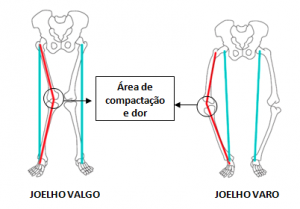
Bunion
It is a progressive misalignment of the big toe (hallux) towards the other toes. In these cases, it is necessary to support the plantar arch to correct pronation and improve the metatarsal positioning (pilot) to prevent the deformity’s progression.
Claw and hammer fingers
This disease is a finger misalignment consequence caused by a metatarsal arch collapse. Therefore, a subtle elevation below the metatarsals called pilot must be introduced to support the metatarsal arch.
The footwear problem
As mentioned earlier, footwear can be a major cause of foot pain. And the footwear problem goes beyond uncomfortable shoes.
Biologically, we were “engineered” to walk barefoot, and our feet were structured to adapt to different types of terrain. However, we barely learn to walk before we put on shoes to protect our feet from the ground and dirt. Such a custom meant that the feet’s musculature did not develop optimally, leaving the muscle tissue less active and more prone to injury.
Another issue is the mass manufacture of shoes. This production model ignores differences between foot types, age, weight, and pain. In Brazil, there is still no option for shoes with different widths. This creates a problem, as people with wider or narrower feet find it difficult to fit in different types of shoes.
Also, most shoes are sold with only fashion and appearance in mind. People themselves, especially women, tend to buy shoes smaller than ideal, just so they don’t look like big feet. On the other hand, men tend to buy much larger shoes than recommended. Ideally, the shoes should have a length gap of about 1 cm to avoid squeezing the toes.
There is no solution for too short shoes, which causes pain, so people often have to buy another pair. As for larger shoes, the fitting can be made with insoles that improve foot accommodation inside the shoes.
The Custom Insole
An interface between the foot and the shoe (insole) solves all these problems and the pain they generate. These custom insoles increase comfort and eliminate pain, including those caused by very long shoes.
The main benefit of the Insole is eliminating pain by redistributing plantar pressure. The Insole has specific curves and elevations, called corrections, which increase the foot’s contact area with the ground and reduce pressure peaks on the soles.
Below is an image representing the pressures on the soles of a person’s feet with and without insoles, measured with a modern German measurement device called Pedar. The pink color represents high-pressure points, and the black color means low pressure.
Another benefit of the insole is biomechanical correction. Custom-made insoles improve foot, ankle, and knee alignment, keeping them neutral. As a result, load distribution throughout the lower limb improves, eliminating compression areas, as shown in the image below.
How do we customize the insoles?
Baropodometer
The device reads the feet and allows the hyper pressure area identification in the foot.
Scanner 3D
Using a laser, the device scans the feet and captures all the sole’s curvatures with a standard deviation of 1 mm.
CAD design
Software that adapts the insole perfectly to the plantar arch and inserts corrections that correct the step and redistribute plantar pressure.
Precision Manufacturing
After a thorough evaluation by a specialist, and a complete scan of the feet on technological equipment, the insoles are designed and sent to the factory.
The insole is manufactured using technological 3D printers. This equipment ensures the final product is exactly like the design. In addition, the material of the insoles is TPU (thermoplastic polyurethane), which is resistant and flexible, guaranteeing comfort and durability.
Results
All this knowledge about the incidence and cause of pain in the population, along with an excellent process of evaluation and insole production, contributed to outstanding results such as:
- More than 50,000 people served and satisfied;
- 97% of people assisted are satisfied;
- We’re not perfect, but we’re close. Only 3% do not have their pain resolved;
- We offer a life free of foot, ankle, and knee pain through knowledge, engineering, and personalized care;
- The cost of this benefit is minimal, mainly since we help eliminate persistent pain. It doesn’t cost more than a good pair of sneakers;
- We solve your pain for a long period (years).
Benefits
- Standing longer and pain-free;
- Practice physical activity without pain;
- Carry out your social activities without pain;
- Get back to doing the activities you enjoy;
- No drugs or interventions, no risk or contraindications.
